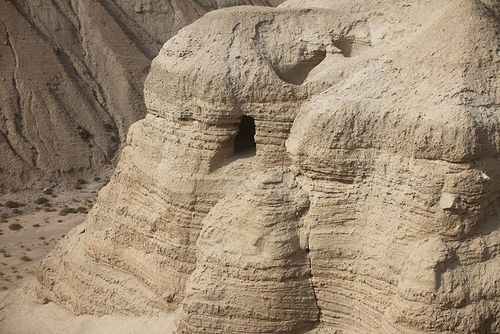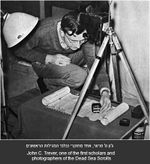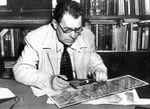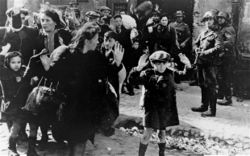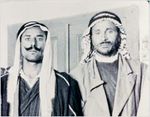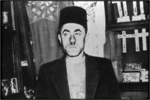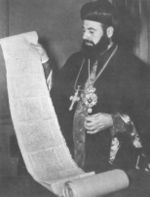Difference between revisions of "Category:Qumran Studies--1940s"
| Line 8: | Line 8: | ||
|logo= history.png | |logo= history.png | ||
|px= 38 | |px= 38 | ||
|content= [[File:Qumran caves.jpg| | |content= [[File:Qumran caves.jpg|500px]] | ||
The page: '''Qumran Studies--1940s''', includes (in chronological order) fictional and literary works in the field of [[Qumran Studies]] made in the 1940s, or from 1940 and 1949. | The page: '''Qumran Studies--1940s''', includes (in chronological order) fictional and literary works in the field of [[Qumran Studies]] made in the 1940s, or from 1940 and 1949. | ||
[[File:John Trever.jpg|thumb|150px|]] | [[File:John Trever.jpg|thumb|150px|]] | ||
[[File:Eliezer Sukenik.jpg|thumb|150px|Israeli archaeologist, Eliezer Sukenik, who purchased three of the seven scrolls from Cave 1]] | [[File:Eliezer Sukenik.jpg|thumb|150px|Israeli archaeologist, Eliezer Sukenik, who purchased three of the seven scrolls from Cave 1]] | ||
}} | |||
{{WindowMain | {{WindowMain | ||
| Line 29: | Line 26: | ||
{{WindowMain | {{WindowMain | ||
|title= | |title= [[Interpreters ([[1940s]]) | ||
|backgroundLogo= Bluebg_rounded_croped.png | |backgroundLogo= Bluebg_rounded_croped.png | ||
|logo = contents.png | |logo = contents.png | ||
| Line 35: | Line 32: | ||
|content= | |content= | ||
* | * [[Eleazar Sukenik]] -- [[John C. Trever]] -- [[Millar Burrows]] -- [[William H. Brownlee]] -- [[Gerald Lankester Harding]] -- [[Roland de Vaux]] | ||
}} | }} | ||
| Line 58: | Line 41: | ||
{| id="mp-right" cellpadding="2" cellspacing="5" style="width:100%; vertical-align:top; background:#f5faff; background:transparent;" | {| id="mp-right" cellpadding="2" cellspacing="5" style="width:100%; vertical-align:top; background:#f5faff; background:transparent;" | ||
{{WindowMain | {{WindowMain | ||
|title= | |title= [[Timeline]] ([[1940s]]) | ||
|backgroundLogo= Bluebg_rounded_croped.png | |backgroundLogo= Bluebg_rounded_croped.png | ||
|logo= history.png | |logo= history.png | ||
|px= 38 | |px= 38 | ||
|content= [[File:Holocaust1.jpg|250px]] | |content= [[File:Holocaust1.jpg|thumb|left|250px]] | ||
[[:Category:Qumran Studies--2020s|2020s]] -- [[:Category:Qumran Studies--2010s|2010s]] -- [[:Category:Qumran Studies--2000s|2000s]] -- [[:Category:Qumran Studies--1990s|1990s]] -- [[:Category:Qumran Studies--1980s|1980s]] -- [[:Category:Qumran Studies--1970s|1970s]] -- [[:Category:Qumran Studies--1960s|1960s]] -- [[:Category:Qumran Studies--1950s|1950s]] -- [[:Category:Qumran Studies--1940s|1940s]] | [[:Category:Qumran Studies--2020s|2020s]] -- [[:Category:Qumran Studies--2010s|2010s]] -- [[:Category:Qumran Studies--2000s|2000s]] -- [[:Category:Qumran Studies--1990s|1990s]] -- [[:Category:Qumran Studies--1980s|1980s]] -- [[:Category:Qumran Studies--1970s|1970s]] -- [[:Category:Qumran Studies--1960s|1960s]] -- [[:Category:Qumran Studies--1950s|1950s]] -- [[:Category:Qumran Studies--1940s|1940s]] | ||
| Line 69: | Line 51: | ||
{{WindowMain | {{WindowMain | ||
|title= | |title= [[Languages]] | ||
|backgroundLogo= Bluebg_rounded_croped.png | |backgroundLogo= Bluebg_rounded_croped.png | ||
|logo= history.png | |logo= history.png | ||
|px= 38 | |px= 38 | ||
|content=[[File:Languages.jpg|250px]] | |content=[[File:Languages.jpg|thumb|left|250px]] | ||
[[:Category:Qumran Studies--English|English]] -- [[:Category:Qumran Studies--French|French]] -- [[:Category:Qumran Studies--German|German]] -- [[:Category:Qumran Studies--Italian|Italian]] -- [[:Category:Qumran Studies--Spanish|Spanish]] -//- [[:Category:Qumran Studies--Arabic|Arabic]] -- [[:Category:Qumran Studies--Bulgarian|Bulgarian]] -- [[:Category:Qumran Studies--Chinese|Chinese]] -- [[:Category:Qumran Studies--Croatian|Croatian]] -- [[:Category:Qumran Studies--Czech|Czech]] -- [[:Category:Qumran Studies--Danish|Danish]] -- [[:Category:Qumran Studies--Dutch|Dutch]] -- [[:Category:Qumran Studies--Finnish|Finnish]] -- [[:Category:Qumran Studies--Greek|Greek]] -- [[:Category:Qumran Studies--Hebrew|Hebrew]] -- [[:Category:Qumran Studies--Hungarian|Hungarian]] -- [[:Category:Qumran Studies--Japanese|Japanese]] -- [[:Category:Qumran Studies--Korean|Korean]] -- [[:Category:Qumran Studies--Latin|Latin]] -- [[:Category:Qumran Studies--Norwegian|Norwegian]] -- [[:Category:Qumran Studies--Polish|Polish]] -- [[:Category:Qumran Studies--Portuguese|Portuguese]] -- [[:Category:Qumran Studies--Romanian|Romanian]] -- [[:Category:Qumran Studies--Russian|Russian]] -- [[:Category:Qumran Studies--Serbian|Serbian]] -- [[:Category:Qumran Studies--Swedish|Swedish]] | [[:Category:Qumran Studies--English|English]] -- [[:Category:Qumran Studies--French|French]] -- [[:Category:Qumran Studies--German|German]] -- [[:Category:Qumran Studies--Italian|Italian]] -- [[:Category:Qumran Studies--Spanish|Spanish]] -//- [[:Category:Qumran Studies--Arabic|Arabic]] -- [[:Category:Qumran Studies--Bulgarian|Bulgarian]] -- [[:Category:Qumran Studies--Chinese|Chinese]] -- [[:Category:Qumran Studies--Croatian|Croatian]] -- [[:Category:Qumran Studies--Czech|Czech]] -- [[:Category:Qumran Studies--Danish|Danish]] -- [[:Category:Qumran Studies--Dutch|Dutch]] -- [[:Category:Qumran Studies--Finnish|Finnish]] -- [[:Category:Qumran Studies--Greek|Greek]] -- [[:Category:Qumran Studies--Hebrew|Hebrew]] -- [[:Category:Qumran Studies--Hungarian|Hungarian]] -- [[:Category:Qumran Studies--Japanese|Japanese]] -- [[:Category:Qumran Studies--Korean|Korean]] -- [[:Category:Qumran Studies--Latin|Latin]] -- [[:Category:Qumran Studies--Norwegian|Norwegian]] -- [[:Category:Qumran Studies--Polish|Polish]] -- [[:Category:Qumran Studies--Portuguese|Portuguese]] -- [[:Category:Qumran Studies--Romanian|Romanian]] -- [[:Category:Qumran Studies--Russian|Russian]] -- [[:Category:Qumran Studies--Serbian|Serbian]] -- [[:Category:Qumran Studies--Swedish|Swedish]] | ||
}} | }} | ||
|} | |||
|} | |||
==History of Research ([[1940s]]) -- Notes == | |||
[[File:Qumran Bedouin.jpg|thumb|150px|The two Bedouin shepherds credited for the discovery of the first Dead Sea Scrolls in Cave 1]] | |||
[[File:Kando.png|thumb|150px|Kando, the cobbler who acted as mediator for the selling of the first Dead Sea Scrolls]] | |||
[[File:Syrian Metropolitan Archbishop.jpg|thumb|150px|The Syrian Metropolitan Archbishop, who purchased four of the seven scrolls from Cave 1]] | |||
The initial discovery of the Dead Sea Scrolls took place between November 1946 and February 1947. Two Bedouin shepherds discovered seven scrolls housed in jars in a cave now known as Cave 1, on the northern shore of the [[Dead Sea]], near the [[Qumran]] site. These scrolls were later identified as the complete [[Isaiah Scroll]], the [[Community Rule]], the [[Pesher Habakkuk]], a second [[Isaiah Scroll]], the [[War Scroll]], the [[Thanksgiving Hymns]], and the [[Genesis Apocryphon]]. | |||
For some time the Bedouin kept the scrolls in their tents, later they contacted some antiquities dealers in Bethlehem in the hope of selling the manuscripts, but without success. Eventually the manuscripts were offered to a Syrian Orthodox cobbler, Khalil Iksander Shahin, nichnamed ''Kando''. Acting as an agent for the Bedouin, Kando sold four manuscripts to the Syrian metropolitan archbishop of Jerusalem, Mar Athanasius Yeshua Samuel (i.e. the complete Isaiah Scroll, the [[Community Rule]], the [[Pesher Habakkuk]], and the [[Genesis Apocryphon]]). The remaining three mss (i.e. the [[Thanksgiving Hymns]], the [[War Scroll]], and then the second Isaiah Scroll) were purchased by Israeli archaeologist [[Eleazar Sukenik]] in Nov-Dec 1947 with funds from the Hebrew University of Jerusalem. | |||
Already in the last week of July 1947, the Syrian Archbishop had contacted Profs. Sebastianus Marmardji and [[Johannes van der Ploeg]] at the Ecole Biblique and Archeologique Francaise de Jerusalem. They identified among the scrolls a copy of Isaiah and a commentary on Habakkuk, but concluded that they were late medieval manuscripts. The Syrian Archbishop then contacted in mid-February 1948 the American Schools of Oriental Research (ASOR). Realizing the antiquity of the scrolls and the importance of the discovery, [[John C. Trever]] on 21 February 1948 photographed, both on black-and-white and standard color film, three of the scrolls (i.e. the complete Isaiah Scroll, the [[Community Rule]], and the [[Pesher Habakkuk]]; the [[Genesis Apocryphon]] was too fragile to be unrolled). Trever immediately called back from Amman, Jordan the head of ASOR, [[Millar Burrows]], and another American young researcher at ASOR [[William H. Brownlee]]. On 11 April 1948, Burrows announced to the scholarly community the discovery of the scrolls in a general press release; the announcement was followed on April 26 by an analogous press release by Sukenik about Hebrew University's scrolls. | |||
At the end of 1948, the government of Jordan finally gave permission to the Arab Legion to search the area where the original Qumran cave was thought to be. Consequently, Cave 1 was identified on 28 January 1949, by Belgian United Nations observer Captain Phillipe Lippens and Arab Legion Captain Akkash el-Zebn. A preliminary excavation of the Cave was conducted from 15 February to 5 March 1949 by the Jordanian Department of Antiquities in collaboration with the Ecole Biblique et Archeologique, under the direction of [[Gerald Lankester Harding]] and [[Roland de Vaux]]. Additional Dead Sea Scroll fragments, linen cloth, jars, and other artifacts were recovered. | |||
In the meantime, on January 29, 1949, the Metropolitan archbishop took the four scrolls in his possession to the United States for exhibition and to secure a buyer. On April 10-14, 1949, the [[Genesis Apocryphon]] was unrolled for the first time at Fogg Museum, Harvard University. The four scrolls "from St. Mark Monastery" were publicly displayed on October 1949 at the Library of Congress, Washington, DC, and then in February 1950 at Duke University. | |||
The first scholarly reports were published in 1948-49 by [[Eleazar Sukenik]] and [[Gerald Lankester Harding]]. | |||
Revision as of 06:26, 21 November 2019
|
|
English -- French -- German -- Italian -- Spanish -//- Arabic -- Bulgarian -- Chinese -- Croatian -- Czech -- Danish -- Dutch -- Finnish -- Greek -- Hebrew -- Hungarian -- Japanese -- Korean -- Latin -- Norwegian -- Polish -- Portuguese -- Romanian -- Russian -- Serbian -- Swedish
|
History of Research (1940s) -- Notes
The initial discovery of the Dead Sea Scrolls took place between November 1946 and February 1947. Two Bedouin shepherds discovered seven scrolls housed in jars in a cave now known as Cave 1, on the northern shore of the Dead Sea, near the Qumran site. These scrolls were later identified as the complete Isaiah Scroll, the Community Rule, the Pesher Habakkuk, a second Isaiah Scroll, the War Scroll, the Thanksgiving Hymns, and the Genesis Apocryphon.
For some time the Bedouin kept the scrolls in their tents, later they contacted some antiquities dealers in Bethlehem in the hope of selling the manuscripts, but without success. Eventually the manuscripts were offered to a Syrian Orthodox cobbler, Khalil Iksander Shahin, nichnamed Kando. Acting as an agent for the Bedouin, Kando sold four manuscripts to the Syrian metropolitan archbishop of Jerusalem, Mar Athanasius Yeshua Samuel (i.e. the complete Isaiah Scroll, the Community Rule, the Pesher Habakkuk, and the Genesis Apocryphon). The remaining three mss (i.e. the Thanksgiving Hymns, the War Scroll, and then the second Isaiah Scroll) were purchased by Israeli archaeologist Eleazar Sukenik in Nov-Dec 1947 with funds from the Hebrew University of Jerusalem.
Already in the last week of July 1947, the Syrian Archbishop had contacted Profs. Sebastianus Marmardji and Johannes van der Ploeg at the Ecole Biblique and Archeologique Francaise de Jerusalem. They identified among the scrolls a copy of Isaiah and a commentary on Habakkuk, but concluded that they were late medieval manuscripts. The Syrian Archbishop then contacted in mid-February 1948 the American Schools of Oriental Research (ASOR). Realizing the antiquity of the scrolls and the importance of the discovery, John C. Trever on 21 February 1948 photographed, both on black-and-white and standard color film, three of the scrolls (i.e. the complete Isaiah Scroll, the Community Rule, and the Pesher Habakkuk; the Genesis Apocryphon was too fragile to be unrolled). Trever immediately called back from Amman, Jordan the head of ASOR, Millar Burrows, and another American young researcher at ASOR William H. Brownlee. On 11 April 1948, Burrows announced to the scholarly community the discovery of the scrolls in a general press release; the announcement was followed on April 26 by an analogous press release by Sukenik about Hebrew University's scrolls.
At the end of 1948, the government of Jordan finally gave permission to the Arab Legion to search the area where the original Qumran cave was thought to be. Consequently, Cave 1 was identified on 28 January 1949, by Belgian United Nations observer Captain Phillipe Lippens and Arab Legion Captain Akkash el-Zebn. A preliminary excavation of the Cave was conducted from 15 February to 5 March 1949 by the Jordanian Department of Antiquities in collaboration with the Ecole Biblique et Archeologique, under the direction of Gerald Lankester Harding and Roland de Vaux. Additional Dead Sea Scroll fragments, linen cloth, jars, and other artifacts were recovered.
In the meantime, on January 29, 1949, the Metropolitan archbishop took the four scrolls in his possession to the United States for exhibition and to secure a buyer. On April 10-14, 1949, the Genesis Apocryphon was unrolled for the first time at Fogg Museum, Harvard University. The four scrolls "from St. Mark Monastery" were publicly displayed on October 1949 at the Library of Congress, Washington, DC, and then in February 1950 at Duke University.
The first scholarly reports were published in 1948-49 by Eleazar Sukenik and Gerald Lankester Harding.
Pages in category "Qumran Studies--1940s"
The following 15 pages are in this category, out of 15 total.
1
- ~~ ~~ 1941 ~~ ~~ ~~
- ~~ ~~ 1942 ~~ ~~ ~~
- ~~ ~~ 1943 ~~ ~~ ~~
- ~~ ~~ 1944 ~~ ~~ ~~
- ~~ ~~ 1945 ~~ ~~ ~~
- ~~ ~~ 1946 ~~ ~~ ~~
- ~~ ~~ 1947 ~~ ~~ ~~
- ~~ ~~ 1948 ~~ ~~ ~~
- מגילות גנוזות (The Dead Sea Scrolls / 1948 Sukenik), book
- ~~ ~~ 1949 ~~ ~~ ~~
- The Dead Sea Scrolls (1949 Harding), essay
- Vorläufige Mitteilungen über die am Nordwestende des Toten Meeres gefundenen hebräischen Handschriften (Preliminary Announcements about the Hebrew Manuscripts Found at the Northwestern End of the Dead Sea / 1949 Hempel), book
